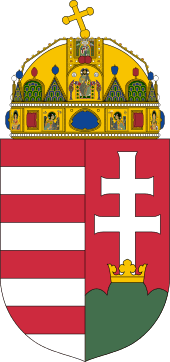Energy in Hungary
Energy in Hungary describes energy and electricity production, consumption and import in Hungary. Energy policy of Hungary describes the politics of Hungary related to energy.
Overview
| Energy in Hungary[1] | ||||||
|---|---|---|---|---|---|---|
| Capita | Prim. energy | Production | Import | Electricity | CO2-emission | |
| Million | TWh | TWh | TWh | TWh | Mt | |
| 2004 | 10.11 | 307 | 119 | 186 | 37.2 | 56.8 |
| 2007 | 10.06 | 311 | 119 | 192 | 40.0 | 53.9 |
| 2008 | 10.04 | 308 | 122 | 198 | 40.0 | 53.0 |
| 2009 | 10.02 | 289 | 128 | 173 | 37.8 | 48.2 |
| 2012 | 9.97 | 290 | 125 | 153 | 38.8 | 47.4 |
| 2012R | 9.92 | 273 | 123 | 145 | 38.9 | 43.6 |
| 2013 | 9.89 | 262 | 119 | 140 | 38.5 | 39.5 |
| Change 2004-09 | -0.9 % | -5.7 % | 7.4 % | -7.2 % | 1.7 % | -15.3 % |
| Mtoe = 11.63 TWh. Prim. energy includes energy losses that are 2/3 for nuclear power[2]
2012R = CO2 calculation criteria changed, numbers updated | ||||||
Nuclear power
Hungary had in 2010 four nuclear power stations with an average age of 24 years.[3]
Oil
MOL Group is an oil and gas group in Hungary.
Gas
Emfesz is a natural gas distributor in Hungary. Panrusgáz imports natural gas from Russia mainly Gazprom.
The Arad–Szeged pipeline is a natural gas pipeline from Arad (Romania) to Szeged (Hungary).
Nabucco and South Stream gas pipelines may be constructed via Hungary to other European countries. The Nabucco gas pipeline is expected to pipe 31bn cubic metres of gas annually in a 3,300 km long pipeline constructed via Hungary, Turkey, Romania, Bulgaria and Austria. The South Stream gas pipeline is expected to pipe 63bn cu m of gas from southern Russia to Bulgaria under the Black Sea. The pipe is planned to run via Hungary to central and southern Europe.[4]
Renewable energy
Hungary is a member of the European Union and thus takes part in the EU strategy to increase its share of the renewable energy. The EU has adopted the 2009 Renewable Energy Directive, which included a 20% renewable energy target by 2020 for the EU.[5] By 2030 wind should produce in average 26-35% of the EU's electricity and save Europe €56 billion a year in avoided fuel costs.[6]
The national authors of Hungary forecast is 14.7% renewables in gross energy consumption by 2020, exceeding their 13% binding target by 1.7 percentage points. Hungary is the EU country with the smallest forecast penetration of renewables of the electricity demand in 2020, namely only 11% (including biomass 6% and wind power 3%). The forecast includes 400 MW of new wind power capacity between 2010-2020. EWEA’s 2009 forecast expects Hungary to reach 1.2 GW of installed wind capacity in this time.[5] In the end of 2010 wind power capacity was 295 MW.[7]
| EU and Hungary Wind Energy Capacity (MW)[8][9][10][11] | ||||||||||||||||
|---|---|---|---|---|---|---|---|---|---|---|---|---|---|---|---|---|
| No | Country | 2012 | 2011 | 2010 | 2009 | 2008 | 2007 | 2006 | 2005 | 2004 | 2003 | 2002 | 2001 | 2000 | 1999 | 1998 |
| - | EU-27 | 105,696 | 93,957 | 84,074 | 74,767 | 64,712 | 56,517 | 48,069 | 40,511 | 34,383 | 28,599 | 23,159 | 17,315 | 12,887 | 9,678 | 6,453 |
| 17 | Hungary | 329 | 329 | 295 | 201 | 127 | 65 | 61 | 17 | 3 | 3 | 3 | 0 | 0 | 0 | 0 |
Global warming
In 2007, emissions of carbon dioxide totalled 53.9 million tonnes or around 5.4 tonnes per capita when the EU-27 average was 7.9 tonnes per capita.[12]
See also
| Wikimedia Commons has media related to Energy in Hungary. |
References
- ↑ IEA Key World Energy Statistics Statistics 2015, 2014 (2012R as in November 2015 + 2012 as in March 2014 is comparable to previous years statistical calculation criteria, 2013, 2012, 2011, 2010, 2009, 2006 IEA October, crude oil p.11, coal p. 13 gas p. 15
- ↑ Energy in Sweden 2010, Facts and figures, The Swedish Energy Agency, Table 8 Losses in nuclear power stations Table 9 Nuclear power brutto
- ↑ Ydinvoima kypsyy länsimaissa hitaasti rakennushankkeiksi, Helsingin Sanomat 8.3.2010 (Finnish)
- ↑ Putin opens Nord Stream Baltic gas pipeline to Germany, BBC 6 September 2011
- 1 2 EU Energy Policy to 2050 EWEA March 2011
- ↑ Wind Energy Factsheets, European Wind Energy Association 2010 page 6
- ↑ Wind in power 2010 European statistics EWEA February 2011 page 4
- ↑ EWEA Staff (2010). "Cumulative installed capacity per EU Member State 1998 - 2009 (MW)". European Wind Energy Association. Retrieved 2010-05-22.
- ↑ EWEA Staff (February 2011). "EWEA Annual Statistics 2010" (PDF). European Wind Energy Association. Retrieved 2011-01-31.
- ↑ EWEA Staff (February 2012). "EWEA Annual Statistics 2011" (PDF). European Wind Energy Association. Retrieved 2011-02-18.
- ↑ Wind in power: 2012 European statistics February 2013
- ↑ Energy in Sweden, Facts and figures, The Swedish Energy Agency 2010, Table 1
